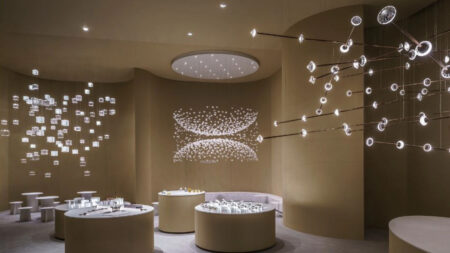It was 2006, winter was in full swing, and there was enough chill and moisture in the air to clothe my village in a blanket of snow for the next few days. I had just snuggled in my quilt and was desperately hoping that it wouldn’t snow for the next few hours. Because if it did, there would be a power cut and I would miss the television premiere of ‘Charlie and the Chocolate Factory,’ a film that I had been waiting to watch for a while.
Hours later, I was still in my bed with my eyes and ears almost numb. This deprivation in senses was not because there was a snow blizzard or a power failure. It was rather a sad thought that I’d never be able to meet the people who created Willy Wonka’s (lead character in Charlie and the Chocolate Factory) magic world: A world full of chocolates, confections, and a lot of mystery. A world, where there is no magic, yet you are hypnotized by the larger-than-life sets by production designer Alex McDowell.
I had seen the complete film without weather interference, and if there was one word I could conclude it in, it was ‘magic!’ I call it magic because the film by director Tim Burton and his production designer Alex McDowell was not only a visual treat but also a present for the heart. Despite the spectacle, I was intrigued to know whether the chocolates, landscapes, and props were really built or were a work of CGI. And the only man with all the answers was Alex McDowell.
Back then I wouldn’t have imagined that I’d even get a chance to talk to a crew member from the film, but nearly 17 years later I had the pleasure of interviewing Alex McDowell, the production designer of Charlie and the Chocolate Factory. If Tim Burton was the man who birthed the world of Willy Wonka, it was Alex McDowell who breathed life into it.
“It was a very complicated film. All of the crazy landscapes from trees, grass, and waterfall you see in the film is really built, courtesy of 400 crew members which is the largest crew I’ve ever had. We had to build a pink transparent boat in the shape of a dragon that had to float on Chocolate River,” Alex tells me in an exclusive conversation.

If you have seen the film, you’d remember a grassy expanse divided by a chocolate waterfall and river. And I had to ask Alex how much of it was real and what proportion was special effects. He tells me, “I don’t remember in any accurate way but I will just guess that it’s 70:30 or something like that, maybe at 80:20. Mostly you’re trying to stay within the set just to be cost-effective and a lot of decisions are being made just to make sure the camera doesn’t create a new visual effect shot just for no good reason.”
McDowell further admitted that this was indeed one of the most challenging projects of his life considering he and his team had to build for the Oompa Loompas as well. “It was an interesting problem because the Oompa Loompa character, the one actor is four-foot-one. And the character he’s playing is 30 inches. So, 49 inches to 30 inches, whatever proportion that is, we had to build any sets that he was in twice,” he informs.

“Everything had to be built wide, the tree had to be a different scale, the landscape, the grass, and everything had to be built oversized so that he looked smaller. So that was a crazy problem but I like that kind of systemic complexity. It’s really something I miss now.” This is the prime reason why he calls himself a man who is intensely curious and gets easily bored.
Charlie and the Chocolate Factory was nominated for the 59th edition of the BAFTA Awards for best production design but lost to Stuart Craig’s production design in the Harry Potter and the Goblet of Fire. McDowell’s legacy however is not defined by the Charlie and the Chocolate Factory alone. He kickstarted his Hollywood career with films like Lawnmower Man and Crow, but what really got him the reckoning was David Fincher’s all-time cult classic, Fight Club.
“Fight Club is probably the favorite movie I’ve worked on. It’s a beautifully crafted movie. The story is incredibly strong and it was very important because it represented something of the moment,” he states. Being in production design, McDowell’s main responsibility was to design ‘The Paper Street House,’ which he calls to be the main character in the movie metaphorically.
Opening up on the design theme of the film, McDowell states, “The design of the Paper Street House had to reflect history. And there was no description in the book or in the script. So we had complete freedom and we decided it had to reflect a hundred-year history.”
McDowell and his team were fed with a narrative that the house was built in 1900 by an industrialist on the outskirts of Detroit and eventually the landscape was taken over by the industrial development. And so the house loses value. Going by the narrative he built five sets that represent the house and it had five or six layers of wallpaper as well. “So if you peel back the layers, there’s wallpaper from the 1920s, the 1950s, 1970s, all built into the set,” he informs.

By 2001, McDowell had done a handful of movies including Fight Club, Fear and Loathing in Las Vegas. He went on to do films like The Terminal, Man of Steel, and Charlie and the Chocolate Factory in the coming years as mentioned above. However, McDowell’s career was shaped and started by a movie that changed the complexion of how filmmaking is done in Hollywood. A movie that forced McDowell to study modern architecture as his sets featured curves, circular shapes, and reflective materials.
The year was 2002. We had heard of a device called a smartphone but had not seen it, and Alex McDowell was hired for a film called Minority Report where Tom Cruise was doing gestural interfaces, which no one was familiar with at that point in time. The world saw Cruise perform intricate and elaborate movements to discover narratively important information.

Some say it was done to emphasize the science fictional universe and inject a dose of coolness into the representation of technology because filming someone simply moving a mouse cursor or typing on a keyboard does not create the same level of narrative actions and sensation that gestures do. Whatever might be the case, the film went down in history as a major hit but very few people actually know that there wasn’t a script finalized for the film for at least a year. Alex explains, why.
“The radical thing about Minority Report for me was there was no script at all for a year. So we had to build a world first and it completely flipped the model of what storytelling could be in the film because we were world-building. And then the story was emerging from the world.”
“When you have a script, the designer is following it and obviously its narrative is linear. But you kind of imagine that that’s a thread or a string of pearls. Each one of those pearls is a little sphere because you don’t know where the director is going to shoot. You don’t know all of the conditions yet. The script is not finished. So you are building these ideas of an environment that may not all yet be shot, but it has a certain logic,” he added.
For people who consider Minority Report to be science fiction, Alex has a message: “Minority Report was specifically not designed to be science fiction. One of the things that we were asked to do by Steven Spielberg was future reality, not science fiction. And that was a very strict rule. So it meant that everything that we have in the movie pretty much comes from research.”
“So if you take the gesture interface, I went to MIT Media Lab which is a very highly respected future kind of engineering space filled with engineers who are trying to create the next level of reality. There was a man called John Anderkoffler, who for his thesis project was developing the idea of a human interface with the gesture-controlled interface. So that was his thesis project as a student, and we hired him as a future historian. We were also in touch with many companies like Apple and Lexus and military research labs as well.”
The film was complete and was a major box office hit. Minority Report was a turning point for McDowell but also for the entire cinema. It was a point that triggered a transformation in design culture as well. The movie became such a cult that it’s still debated in news circles on its predictions.
“It’s still having an impact, I would say. Nobody was expecting that to be true. But because of the way, because of the vision that was in the script and story, and how the future was being supported by this kind of progressive ideas around how the world would work, what we’re seeing is still like last maybe two months ago, I saw a proposal for vertical public mobility that moved vertically and horizontally. We’re seeing somebody who’s really trying to build that system. But we designed this in 2000. There was no Internet of Things. There was no user interface like that. There was no kind of quantum physics associated with, the mechanics of memory,” he stresses.
After all the success seen over the years, Alex is now heading Experimental Design Studio– a multi-platform, cross-discipline narrative design studio at the forefront of World Building. Led by McDowell, every project and partnership begins with the creation of a world.

“World Building is a way of reconnecting to human storytelling, I think, that it’s fundamentally collaborative. It is a design process, so it’s systemic. It takes into account the holistic. And so in many ways, we’re really just breaking down the way the world works. We don’t live in a linear narrative society with nothing about the human experience being linear, really, except time moves us forward. So the notion of oral storytelling is kind of the substantial influence,” he notes.
“There are a lot of problems that are still interesting to solve, you know, as a designer, I think that’s probably the case. And, the part of being curious and bored, I think is part of it, every time we kind of fall into a rut of a specific set of solutions to problems, then I’m going to try and disrupt that and make it more interesting again. But also the problems are becoming more and more complex. And that in itself, as a designer, keeps me moving forward,” Alex concludes.
McDowell also reflected his thoughts on the production design of the late 90s and elucidated on the importance of ‘World Building’. During this engaging conversation with Homecrux, the Production Designer turned Narrative Designer also speaks on the vivid experience he has garnered working with Steven Spielberg, David Fincher, Zack Snyder, Tom Cruise, and Johnny Depp.
Watch the full interview on the Homecrux YouTube channel.
Follow Homecrux on Google News!




